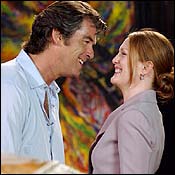
That indefinable something that makes for a great romantic-comedy team is conspicuously absent in Laws of Attraction, which stars Julianne Moore and Pierce Brosnan as dueling New York divorce lawyers who, of course, fall in love and get married, though not necessarily in that order. When we first meet her, Moore’s tough-as-nails Audrey Woods is too busy—i.e., too frigid—to date; her sexed-up, much-married mother (Frances Fisher) is constantly nagging her to get hitched. Brosnan’s Daniel Rafferty appears on the scene as some kind of Lothario Prince Charming, and—voilà—Audrey defrosts. The actors work hard to concoct some chemistry, but it’s tough to be Tracy and Hepburn, let alone Doris Day and Rock Hudson, when you’re trying to get your mouth around lines that wouldn’t pass muster on a UPN sitcom.
“It’s tough to be Tracy and Hepburn when your lines wouldn’t pass muster on a UPN sitcom.”
The apparent subtext of this movie is far more amusing than the text: Daniel is made out to be a real smoothie, and yet no mention is ever made of any previous amorous interludes, nor does he seem to have ever been married. At one point, Audrey walks in on him while he’s slumbering with a copy of André Gide’s journals open on his chest. What’s going on here? (Now, if it were Genet … ) Laws of Attraction would have been much more fun if Daniel were simply played as gay. Julianne Moore could have recapitulated Far From Heaven—this time as farce.
John Cadigan first showed signs of schizophrenia in 1991 while a student at Carnegie Mellon, where he showed great aptitude as a printmaker. His condition degenerated until he moved to California to be closer to his family, where his sister Katie, a movie producer, taught him how to use a camera. People Say I’m Crazy is John’s self-portrait, starting in 1997, and it’s a bracing antidote to the usual Beautiful Mind–style Hollywoodization of mental illness. At first, John is given a battery of medications that cause him to gain 150 pounds, but by 1999, his psychiatrist had hit upon the right treatment regimen. Since then, he has been able to manage his condition, living on his own for the first time since college and creating startling, semi-abstract woodcuts in his Palo Alto studio—some of which have toured in galleries across the country.
Clearly, John’s printmaking is also a highly effective form of therapy. So is his moviemaking. The sheer will to chronicle his life must have been enormous; at times, when he is too wiped out to go on, or when his paranoia becomes too acute, he simply clicks off the camera. John interviews many of the people closest to him, including his siblings, his parents, and a gregarious friend, Anne, who is also schizophrenic and calls him her “adopted son.” They don’t gild their responses. His mother, in particular, is very open about her fears. At one point, she tells John, “I don’t know how to reach out to you.” And yet, of course, her very participation in this remarkable film is a kind of reaching out. Her son’s movie repays her trust.
The iconoclastic Canadian director Guy Maddin often melds styles ranging from the early silents to rock-video avant-garde. His films, which include Twilight of the Ice Nymphs and the television ballet Dracula: Pages From a Virgin’s Diary, are cult classics, but his innate playfulness also makes his work accessible for mainstream audiences (assuming they can track the films down). The Saddest Music in the World, adapted by George Toles from a screen story by Kazuo Ishiguro (The Remains of the Day), has a marvelous comic premise. It’s 1933 in Winnipeg, at the height of the Depression. As a marketing ploy, a beer baroness (Isabella Rossellini) stages an international contest to find the saddest of songs. Nations square off in staged dirge-athons aired over the radio until all but one is eliminated—TV game-show moguls ought to take note. (In one of the best matches, the plaintive clang of Siam goes up against Mexican mariachi kitsch.) Too much of this fantasy is filled out with artsy folderol, but it’s a movie like no other—except, maybe, one by Guy Maddin.